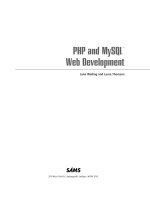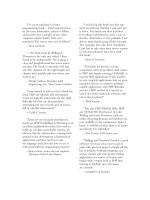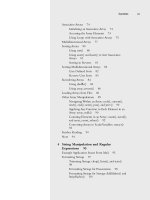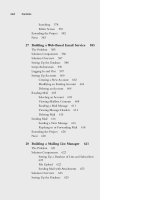PHP and MySQL Web Development - P89 ppsx
Bạn đang xem bản rút gọn của tài liệu. Xem và tải ngay bản đầy đủ của tài liệu tại đây (81.99 KB, 5 trang )
412
Chapter 19 Generating Images
You can use a similar approach to draw line graphs, and even pie charts, if you are good
at mathematics.
Other Image Functions
In addition to the image functions we have used in this chapter, there are functions to let
you draw curved lines (ImageArc()) and polygons (ImagePolygon()), as well as varia-
tions on the ones we have used here.Always begin by sketching what you want to draw,
and then you can hit the manual for any extra functions you might need.
Further Reading
A lot of reading material is available online. If you’re having trouble with the image
functions, it sometimes helps to look at the source documentation for gd because the
PHP functions are wrappers for this library.The gd documentation is available at
/>There are also some excellent tutorials on particular types of graph applications, particu-
larly at Zend and Devshed:
The bar chart application in this chapter was inspired by the dynamic bar graph script
written by Steve Maranda, available from Devshed.
Next
In the next chapter, we’ll tackle PHP’s handy session control functionality, new in
PHP 4.
24 525x ch19 1/24/03 2:57 PM Page 412
20
Using Session Control in PHP
THIS CHAPTER WILL DISCUSS THE SESSION
control functionality in PHP 4.
We will cover
n
What session control is
n
Cookies
n
Setting up a session
n
Session variables
n
Sessions and authentication
What Session Control Is
You might have heard it said that “HTTP is a stateless protocol.”What this means is that
the protocol has no built-in way of maintaining state between two transactions.When a
user requests one page, followed by another, HTTP does not provide a way for us to tell
that both requests came from the same user.
The idea of session control is to be able to track a user during a single session on a
Web site.
If we can do this, we can easily support logging in a user and showing content
according to her authorization level or personal preferences.We can track the user’s
behavior.We can implement shopping carts.
In earlier versions of PHP, session control was supported via PHPLib, the PHP Base
Library, which is still a useful toolkit.You can read about it at
/>As of version 4, PHP includes native session control functions.They are conceptually
similar to PHPLib, but PHPLib offers some extra functionality. If you find that the native
functions do not quite meet your needs, you might want to take a look at it.
25 525x ch20 1/24/03 2:57 PM Page 413
414
Chapter 20 Using Session Control in PHP
Basic Session Functionality
Sessions in PHP are driven by a unique session ID, a cryptographically random number.
This session ID is generated by PHP and stored on the client side for the lifetime of a
session. It can be either stored on a user’s computer in a cookie, or passed along through
URLs.
The session ID acts as a key that allows you to register particular variables as so-called
session variables.The contents of these variables are stored at the server.The session ID is
the only information visible at the client side. If, at the time of a particular connection
to your site, the session ID is visible either through a cookie or the URL, you can access
the session variables stored on the server for that session. By default, the session variables
are stored in flat files on the server. (You can change this to use a database if you are
willing to write your own function—more on this in the section “Configuring Session
Control.”)
You have probably used Web sites that store a session ID in the URL. If there’s a
string of random looking data in your URL, it is likely to be some form of session con-
trol.
Cookies are a different solution to the problem of preserving state across a number of
transactions while still having a clean looking URL.
What Is a Cookie?
A cookie is a small piece of information that scripts can store on a client-side machine.
You can set a cookie on a user’s machine by sending an HTTP header containing data
in the following format:
Set-Cookie: NAME=VALUE; [expires=DATE;] [path=PATH;]
[domain=DOMAIN_NAME;] [secure]
This will create a cookie called NAME with the value VALUE.The other parameters are all
optional.The expires field sets a date beyond which the cookie is no longer relevant.
(Note that if no expiry date is set, the cookie is effectively permanent unless manually
deleted by you or the user.) Together, the path and domain can be used to specify the
URL or URLs for which the cookie is relevant.The
secure keyword means that the
cookie will not be sent over a plain HTTP connection.
When a browser connects to an URL, it first searches the cookies stored locally. If
any of them are relevant to the URL being connected to, they will be transmitted back
to the server.
Setting Cookies from PHP
You can manually set cookies in PHP using the setcookie() function. It has the fol-
lowing prototype:
int setcookie (string name [, string value [, int expire [, string path
[, string domain [, int secure]]]]])
25 525x ch20 1/24/03 2:57 PM Page 414
415
Basic Session Functionality
The parameters correspond exactly to the ones in the Set-Cookie header mentioned
previously.
If you set a cookie as
setcookie ('mycookie', 'value');
when the user visits the next page in your site (or reloads the current page), you will
have access to the cookie via either $_COOKIE['mycookie'] or
$HTTP_COOKIE_VARS["mycookie"]. (Or, if you have register_globals turned on, directly
as $mycookie.)
You can delete a cookie by calling setcookie() again with the same cookie name
and an expiry time in the past.You can also set a cookie manually via the Header()
function and the cookie syntax given previously. One tip is that cookie headers must be
sent before any other headers, or they will not work. (This is a cookie limitation rather than
a PHP limitation.)
Using Cookies with Sessions
Cookies have some associated problems: Some browsers do not accept cookies, and some
users might have disabled cookies in their browsers.This is one of the reasons PHP ses-
sions use a dual cookie/URL method. (We’ll discuss more about this in a minute.)
When you are using PHP sessions, you will not have to manually set cookies.The ses-
sion functions will take care of this for you.
You can use the function
session_get_cookie_params() to see the contents of the
cookie set by session control. It returns an associative array containing the elements
lifetime, path,and domain.
You can also use
session_set_cookie_params($lifetime, $path, $domain [, $secure]);
to set the session cookie parameters.
If you want to read more about cookies, you can consult the cookie specification on
Netscape’s site:
/>(You can probably ignore the fact that this document calls itself a “preliminary specifica-
tion”—it’s been that way since 1995.)
Storing the Session ID
PHP will use cookies by default with sessions. If possible, a cookie will be set to store
the session ID.
The other method it can use is adding the session ID to the URL.You can set this to
happen automatically if you compile PHP with the enable-trans-sid option.This is
the default from PHP 4.2 onward.
25 525x ch20 1/24/03 2:57 PM Page 415
416
Chapter 20 Using Session Control in PHP
Alternatively, you can manually embed the session ID in links so that it is passed
along.The session ID is stored in the constant SID.To pass it along manually, you add it
to the end of a link similar to a GET parameter:
<a href="link.php?<?=SID?>">
It is generally easier to compile with enable-trans-sid, where possible.
Implementing Simple Sessions
The basic steps of using sessions are
n
Starting a session
n
Registering session variables
n
Using session variables
n
Deregistering variables and destroying the session
Note that these steps don’t necessarily all happen in the same script, and some of them
will happen in multiple scripts. Let’s talk about each of these steps in turn.
Starting a Session
Before you can use session functionality, you need to actually begin a session.There are
three ways you can do this.
The first, and simplest, is to begin a script with a call to the session_start() func-
tion:
session_start();
This function checks to see whether there is already a current session ID. If not, it will
create one. If one already exists, it essentially loads the registered session variables so that
you can use them.
It’s a good idea to call session_start() at the start of all your scripts that use ses-
sions.
Second, a session will be started when you try to register a session variable using ses-
sion_register()
(see the next section).
The third way you can begin a session is to set PHP to start one automatically when
someone comes to your site.You can do this with the session.auto_start option in
your php.ini file—we’ll look at this when we discuss configuration.
Registering Session Variables
Registering session variables has recently changed in PHP.
Session variables are stored in the superglobal array $_SESSION as of PHP 4.1, and
also in the older $HTTP_SESSION_VARS. In order to create a session variable you simply
set an element in one of these arrays, as follows:
25 525x ch20 1/24/03 2:57 PM Page 416









